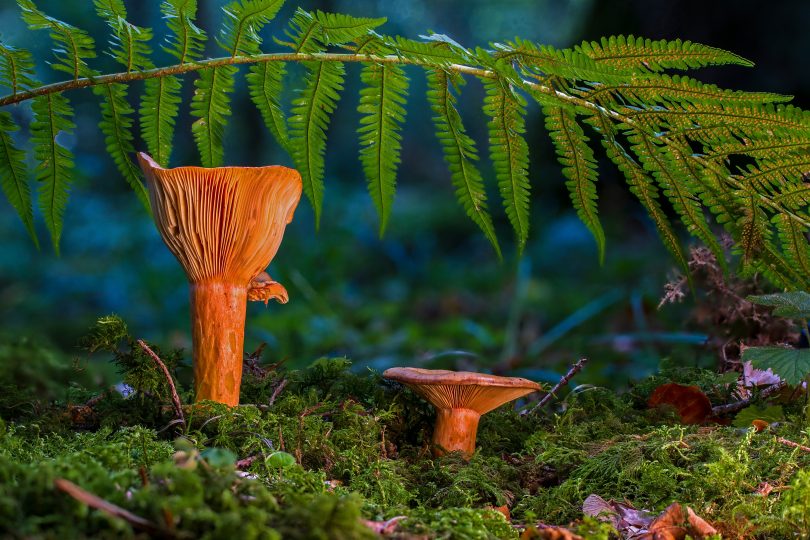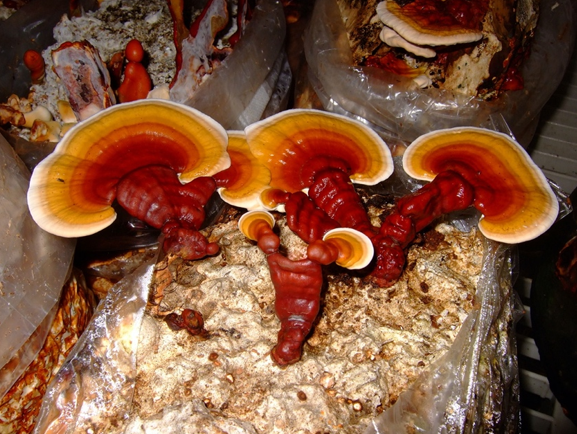The recorded use of medicinal mushrooms dates back about 2,500 years. [1] Mushrooms guard a cornucopia of potential medicinal benefits, extending even to nootropics. Although there are myriad bioactive chemicals in mushrooms, triterpenes are one component with significant potential.
Triterpenes (C30H48) have three terpene units (C10H16), and there are at least 5,000 triterpenes occurring widely in nature. [2] On top of that, there are roughly 140,000 species of mushroom, most still a mystery. [3] Thus, we are only beginning to identify the powerful effects of triterpenes from certain mushrooms.
Ganoderma lingzhi (reishi). By frankenstoen, CC BY 2.0.
For example, three triterpenes were isolated from Pleurotus eryngii, also known as king trumpet or king oyster. [4] These triterpenes—lupeol and novel compounds 2,3,6,23-tetrahydroxy-urs-12-en-28-oic acid and 2,3,23-trihydroxy-urs-12-en-28-oic acid—were tested against breast cancer cell lines in vitro. All three significantly inhibited the growth of tumor cells, and the novel compounds displayed even greater efficacy than lupeol. [4]
Ganoderic acid A. Edgar181, Public Domain.
Perhaps more well-known are the ganoderic acids. These triterpenes are common in Ganoderma mushrooms, particularly as found in Ganoderma lingzhi, or reishi. [5] Ganoderic acid A appears to make the chemotherapy drug cisplantin more available and boosts the rate of apoptosis (cancer cell death). [6] Ganoderic acids TR and DM, on the other hand, have proven effective at inhibiting 5α-reductase activity. [7] 5α-Reductase helps metabolize male steroid hormones (i.e., testosterone to dihydrotestosterone), and too-high levels can lead to disorders related to prostate growth and hair loss. [8] Molecules that inhibit 5α-reductase activity are therefore of great interest. [7,8] To mention a few more, ganoderic acids R and S are associated with protective effects in the liver upon exposure to toxic or inflammatory chemicals. [9]
Lanostane. Edgar181 Public Domain.
Many triterpenes from a group known as lanostanes have also been identified in Ganoderma mushrooms. [10-12] Early evidence indicates the some, but not all, of these triterpenes inhibit two important enzymes: HMG-CoA reductase and α-glucosidase. [10-12] HMG-CoA reductase regulates the production of cholesterol, and inhibitors are known as statins. [13] α-Glucosidase helps kickstart the digestion of simple carbohydrates and inhibitors are relevant to therapy for type II diabetes.
Betulin. V8rik, CC BY-SA 3.0.
Another mushroom with relatively well-known triterpenes is Inonotus obliquus, or chaga. Betulin is a famous example found in chaga. [14] Betulin features as the key compound in a European-approved medication for partial-thickness skin wounds due to its anti-inflammatory, anti-bacterial, and wound-healing properties.
Chaga. Charles de Mille-Isles, flickr, CC By 2.0
Two other triterpenes in chaga, betulinic acid and botulin, have shown significant activity against human adenocarcinoma and lung cancer cell lines. [14] Yet another, more recently discovered triterpene, betulin-3-O-caffeate, has been found to reduce nitric oxide (NO) production in macrophages. NO production signals inflammation and plays a role in autoimmune disease. [14]
Thus, triterpenes play an important role in the medicinal benefits of mushrooms. After longtime use in traditional medicine, medicinal mushrooms are now recovering their popularity as therapeutic gifts from nature.
Header image: adege from Pixabay
References
- Lucius K. Medicinal mushrooms: Current use in clinical practice. Altern Complement Ther. 2020;26(3):119-126. doi:10.1089/act.2020.29275.kha. [Impact Factor: 2.256; Times Cited: n/a]
- Breitmaier E. 6 Triterpenes. Terpenes. Wiley-VCH Verlag GmbH & Co. KGaA, Weinheim; 2006:86.
- Lindequist U, Kim HW, Tiralongo E, van Griensven LV. Medicinal mushrooms. Evidence-based Complementary and Alternative Medicine. 2014;2014(806180). [Impact Factor: 1.813; Times Cited: 49 (Semantic Scholar)]
- Xue Z, et al.Structure identification of triterpene from the mushroom Pleurotus eryngii with inhibitory effects against breast cancer. Plant Foods Hum Nutr. 2015;70:291–296. https://doi.org/10.1007/s11130-015-0492-7. [Impact Factor: 2.901; Times Cited: 16 (Semantic Scholar)]
- Saljoughian M. Adaptogenic or medicinal mushrooms. US Pharm. 2009;34(4):16-18. [Impact Factor: 0.160; Times Cited: n/a]
- Guggenheim AG, Wright KM, Zwickey HL. Immune modulation from five major mushrooms: Application to integrative oncology. Integr Med (Encinitas). 2014;13(1):32-44. [Impact Factor: 2.446; Times Cited: 23 (Semantic Scholar)]
- Liu J, Kurashiki K, Shimizu K, Kondo R. Structure-activity relationship for inhibition of 5alpha-reductase by triterpenoids isolated from Ganoderma lucidum. Bioorg Med Chem. 2006;14(24):8654-8660. doi:10.1016/j.bmc.2006.08.018. [Impact Factor: 3.073; Times Cited: 48 (Semantic Scholar)]
- Marks LS. 5α-Reductase: History and clinical importance. Rev Urol. 2004;6 Suppl 9(Suppl 9):S11-S21. [Impact Factor: 9.333; Times Cited: 24 (Semantic Scholar)]
- Gao Y, et al. Protective effect of Ganoderma (a mushroom with medicinal properties) against various liver injuries. Food Reviews International. 2005;21(1), 27–52.doi:10.1081/fri-200040586. [Impact Factor: 4.113; Times Cited: 6 (Semantic Scholar)]
- Chen B, Tian J, Zhang J, et al. Triterpenes and meroterpenes from Ganoderma lucidum with inhibitory activity against HMGs reductase, aldose reductase and α-glucosidase. Fitoterapia. 2017;120:6-16. doi:10.1016/j.fitote.2017.05.005 [Impact Factor: 2.527; Times Cited: 14 (Semantic Scholar)]
- Wang K, Bao L, Xiong W, et al. Lanostane triterpenes from the Tibetan medicinal mushroom Ganoderma leucocontextum and their inhibitory effects on HMG-CoA reductase and α-glucosidase. J Nat Prod. 2015;78(8):1977-1989. doi:10.1021/acs.jnatprod.5b00331. [Impact Factor: 4.527; Times Cited: 54 (Semantic Scholar)]
- Chen XQ, Zhao J, Chen LX, Wang SF, Wang Y, Li SP. Lanostane triterpenes from the mushroom Ganoderma resinaceum and their inhibitory activities against α-glucosidase. Phytochemistry. 2018;149:103-115. doi:10.1016/j.phytochem.2018.01.007. [Impact Factor: 3.044; Times Cited: 14 (Semantic Scholar)]
- Bansal AB, Cassagnol M. HMG-CoA reductase inhibitors. [Updated 2020 Aug 11]. In: StatPearls [Internet]. Treasure Island (FL): StatPearls Publishing; 2020. Available from: https://www.ncbi.nlm.nih.gov/books/NBK542212/
- Wold CW, Gerwick WH, Wangensteen H, Inngjerdingen KT. Bioactive triterpenoids and water-soluble melanin from Inonotus obliquus (Chaga) with immunomodulatory activity. J Funct Foods. 2020;71:104025. doi:https://doi.org/10.1016/j.jff.2020.104025. [Impact Factor: 3.701; Times Cited: 2 (Semantic Scholar)]













